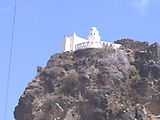Syedna Hatim

| Part of a series on Shia Islam |
| Ismailism |
|---|
 |
| Concepts |
| Seven Pillars |
| History |
|
| Early Imāms |
|
| Groups and present leaders |
Syedna Hatim Bin Ibrahim al-Hamidi[1] (died 16 Muharram 596 AH (6 November 1191 AD), Huteb, Yemen) was the third Da'i al-Mutlaq (Absolute Missionary) of the Taiyabi Musta‘lī Bohra Islam. He was of the Banu Hamdan tribe of Yemen and succeeded his father, the 2nd Dai Sayedna Ibrahim, to the religious post.
During his tenure as Da'i, Syedna Hatim[2] appointed as his associates :
- Syedna Mohammad bin Taher Harisi( Mazoon) (Author of Book - Majmū‘ al-tarbiyah)
- Syedna Ali bin Mohammad Valeed
Syedna Hatim became Da'i al-Mutlaq on 17 Shaban 557 AH[2](1 August 1126 AD). His preachings were followed by the Hamadan and Hamir tribes. Syedna Hatim had been made owner of the Kokaban fort. The Sultan Ali Alyaami at Sana'a became envious of Hatim, so Hatim move to Hutaib where he remained until his death. He appointed his son, Syedna Ali ibn Hatim al-Hamidi as successor the fourth Dai.

There is mausoleum of Hatim bin Ibrahim, adorned with Quranic verses, at center place of the village of Hutaib in the Haraz Mountains, where a community of Yemeni Dawoodi Ismailis lives.
It is believed that Da’i Hatim himself built the mosque overlooking the village of Hutaib to worship in it and to honour Queen Arwa al-Sulayhi, al-Sayyida al-Hurra (The Noble Lady), who ruled Yemen for over five decades from 1084 to 1138.
The Da'i modified and formalized the structure of the Ismaili da’wa (mission), in an evolution from its origins in Fatimid Egypt that wouldn’t change to the present day.
Hatim was a prolific writer and poet, and an organizer of the faith. He used to give 'sabak' (lessons) to his associates and do his writings at a platform under curved roof of mountain nearby. Among his many writings[2] are:
- Tuhfatal Qulub
- Majalis Hatimiya
- Tanbihul Gafeleen
- Shumushul Zaherah
-

View of the Mausoleum from above
-

This is where Syedna Hatim used to go and pray. It is located on a mountain near his Mausoleum
-
Grave Syedna Hatim
-
Hatimi Mosque under focus
-

Place of preaching and writing, platform under curved roof of mountains
-

Mausoleum,mosque together
References
- List of Syednas (according to Dawoodi Bohras)
- Daftary, Farhad, The Ismaili, Their History and Doctrine(Chapter -Mustalian Ismailism-p. 300-310)
- Lathan, Young, Religion, Learning and Science
- Bacharach, Joseph W. Meri, Medieval Islamic Civilisation
- Daftary, Farhad, Sayyida Hurra: The Isma‘ili Sulayhid Queen of Yemen
- Bin Hasan, Idris, Uyun al-akhbar (Bin Hasan was the 19th Da'i of the Dawoodi Bohra. This volume is a history of the Ismaili community from its origins up to the 12th century CE., the period of the Fatimid caliphs al-Mustansir (d. 487/1094), the time of Musta‘lian rulers including al-Musta‘li (d. 495/1101) and al-Amir (d. 524/1130), and then the Tayyibi Ismaili community in Yemen.)
- Hamdani, Abbas. The Dai Hatim ibn Ibrahim al Hamidi and his Book 'Tuhfat al Qulub'. Oriens. XXIII/XXIV. pp. 258–300.
- Hadiyah, Dawate (1416 AH), Sighla-el-Yemen....
- Hatimi-Yemen, Faize, Nubdat min akhbar Hudat Kiram-Yemen
- http://www.sigatulyemen.com/ - 2007
- Surka, Saifee, Mulla Saifuddin Surka n.k.d. Ahmedabad (on Multiply.com)
- Ismailis: From Yemen to India and Back,by: Mira Baz & Photos by Peter J. Willems
- Syedna Hatim (RA), 3rd Dai, Mumineen.org
Reference List
See also
| |||||

